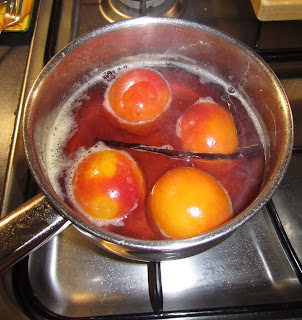Oh yes, you read the title right. In a fit of ridiculous domestication last weekend, B and I decided to make marmalade. From scratch.
Riverford offer a "kit" (i.e., oranges in a brown bag that has "marmalade" written on it, I'm such a sucker for marketing ploys) and since they could deliver it right to our doorstep, we decided to give it a go.
Here are some observations on marmalade-making:
1.) It is fiddly, and time-consuming. Don't start the process if you're pushed for time; you'll only end up frustrated and annoyed.
2.) It will fill your house with an incredibly strong smell of warm oranges. This is delicious, but it doesn't mingle well with other yummy smells, for example that of a
rabbit pie baking in the oven. Just to let you know.
3.) It will be messy. You will need newspaper.
4.) Holy moly, it uses a LOT of sugar. You'll never look at marmalade in the same way again.
Seville Orange Marmalade (made 7 jars of varying sizes)
You need:
1 marmalade-making kit from Riverford, or 1.5kg Seville oranges and 2 unwaxed lemons
2.5 litres cold water
2kg bag granulated sugar (although we used caster, because I forgot to take the recipe to the supermarket, and it worked fine. You don't need that fancy 'jam-making' sugar. That's one marketing ploy I didn't fall for. Ha!)
Kit:
Large bowl
Huge pan (we used our tall pasta pan to minimise sugary splashes all over the kitchen)
Muslin
Large measuring jug
Screw-top jars and lids, sterilised (put them through a hot wash in the dishwasher, then don't touch them again until you need them)
Wax discs, if you like (ours came from
Lakeland, which is my latest shopping obsession. I bought a whole reel of
labels from there as well. I could spend hours, and several fortunes, on their gorgeous kitchen knick-knackery. TANGENT.)
You do:
Firstly, drape the muslin over the bowl, and set aside. Next, take your oranges and lemons.
Peel with a sharp grater (or knife, if you're handy). You want thin strips of rind, ideally without any pith. As each orange is denuded, slice it in half and throw both halves into the muslin-lined bowl, squeezing out the juice as you go.
Slice the strips of pith into thinnish slices (depending on how chunky you like your marmalade to be). These slices can be put directly into your tall pan.
Once all your fruit has been sliced and diced, gather up the sides of the muslin to form a big bundle and squish it hard to release any remaining juice. Tie the ends together so that the fruit stays together.
Pour the juice from the bowl into the pan with your sliced peel. Add 2.5 litres cold water.
Now put the muslin bag, full of fruit, into the pan. Hang the ends of the muslin over the edges of the pan, so that the bag is easily accessible. Heat the pan until the water comes to the boil, then reduce to a gentle simmer and leave to bubble away for two hours. (I wasn't lying when I said this was time-consuming.)
After two hours, when the peel is beautifully soft, remove the muslin bag from the pan. Put it into a colander over the pan and use a wooden spoon to mush out all of the juice from the bag. Carefully pour the contents of the pan into a measuring jug, and get ready for some mental arithmetic - you need 450g sugar for every 500ml liquid. Return the liquid to the pan, then add the right amount of sugar and stir. Gently heat for around ten minutes, until the sugar crystals have dissolved and there's no lumpiness at the bottom of the pan. Turn up the heat and bring the pan contents up to a fast boil. Keep your eyes on the pan at all times, being ready to turn the heat down slightly if it threatens to boil over.
Riverford will tell you that you need to boil the marmalade rapidly for 15 minutes before its ready. This, my dear readers, is a lie. I recommend about an hour. What? Don't give me that look. I warned you not to start this if you were short on time/patience.
Put a saucer to chill in the fridge. After about an hour of boiling, test the marmalade by dropping a teaspoonsful onto the saucer. If it looks thick and viscous, push the surface gently backwards with your spoon. If the liquid wrinkles, it's ready. If not, stick the saucer back in the fridge and try again in ten minutes. You might find you do this several (many) times before the all-important wrinkling occurs.
As soon as you have wrinkly marmalade, turn off the heat and let the pan sit for fifteen minutes. Take your jars and lids out of the dishwasher and pop them in a low oven to warm through.
After fifteen minutes, skim the scum off the surface off the marmalade. Take out your jars, and line them up. Spoon the marmalade into the jars - this will be messy, but go with it. Put the wax discs on top of each jar, then screw on the lids while the marmalade is still warm.
Ta da!
You should feel very proud, you marmalade-making, domestic god/dess you. That's about a year's worth of breakfasts sorted.
















